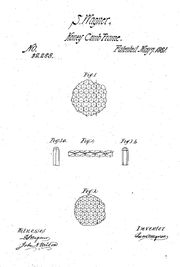Samuel Wagner (1798-1872) was a 19th-century banker and journalist who founded the American Bee Journal in 1861. He oversaw operations from its beginnings to the time of his death in 1872. Wagner had relaunched the Journal in 1866 from his new residence in Washington, DC. This followed the magazine's only period of suspended operations, the duration of the American Civil War.
Early life
Wagner was born on August 17, 1798 in York, Pennsylvania, where his father served as pastor of the borough's German Reformed Church. Soon after Samuel's birth, the family moved to Frederick, Maryland, where his father had a new opportunity attending the pastoral needs of the community's German Reformed congregation. In time, Samuel was enrolled in the parochial school attached to the church. When his father resigned his position in 1810 due to poor health, the family returned to York. Samuel's father soon thereafter died. Wagner continued his studies at York County Academy where he would eventually complete his education.[1] Since the Wagner family spoke only German at home during Samuel's first 10 years, he was fully fluent, and well-prepared for his future pursuits in the study of bee culture in Germany.
Professional career
Wagner first pursued mercantile activities for several years before trying his hand in journalism. He then purchased the local York Recorder in 1824, later selling it to Mr. T. C. Hamley in 1829. Wagner relocated to Lancaster, where he would establish the Lancaster Examiner in April 1830. He ran the newspaper for four years until offered the management position of "cashier" for York Bank. He sold the Examiner to Hammersley & Richards in April 1834, and returned to York to commence his work at the bank.[1]
Wagner retained his "cashiership" at York Bank over a span of 28 years. This period of his career overlapped with his 1861 founding of the American Bee Journal. In March 1863, he was appointed as financial clerk of the United States Senate by "Colonel" J. W. Forney [2]. Wagner held that position into December 1867 when a financial audit of his office disclosed a $35,486 account deficit. He immediately resigned his position in response.[3] For the few remaining years of his life, Wagner devoted all his energies to the editing and management of the American Bee Journal.
Journalism, writing, and correspondence
Inventions

Wagner's Patent Foundation
Wagner secured a patent on the manufacture of artificial comb foundation in 1861.[4] Artificial foundation had already been invented in 1857 by Johannes Mehring of Germany, but Mehring's foundation only imprinted the cell bottoms. Although Wagner did not succeed in bringing his process to market, his patent probably delayed perfection of the process in the United States by others.[5]
Wagner later secured an additional patent for an improved honey extractor with long-time friend, L. L. Langstroth in 1867.[6] Their centrifugal apparatus was powered by a gear-driven shaft. This feature is still used in modern extractors.
L.L. Langstroth may have been aware of Dzierżon's discoveries prior to submitting his patent application. In the summer of 1851, he was introduced to Dzierżon's work by Samuel Wagner, who had translated it from the German language original. Wagner later founded the American Bee Journal.[5] Moreover, Samuel Wagner visited Jan Dzierżon in his apiaries in Silesia (now Poland). Wagner also subscribed to Bienen-Zeitung, the journal in which Dzierżon published his apiarian works. Wagner's translation of Theorie und Praxis, ... was never published; instead, Langstroth published his A Practical Treatise on the Hive and Honey-Bee.
Already in 1852 he wrote a letter to Lorenzo Langstroth from the Bank of York on the results obtained in Germany on a new hive management system, well above the known applying in their apiaries. This letter was published on page 17 and 18 A Practical Treatise on the Hive and Honey-bee . written by Lorenzo Langstroth .
LL Langstroth knew all about the desccubrimientos of Jan Dzierzon . Before November 1, 1851 He read Theorie und Praxis, ... Jan Dzierzon published in 1848. Samuel Wagner the founder of American Bee Journal in 1850 translated the work or the Langstroth made available in the summer of 1851. [ 3]. Moreover, Samuel Wagner visited Jan Dzierzon in their apiaries in Silesia (now Poland). Wagner also signed the Bienen-Zeitung the journal in which Dzierzon published his works. The translation of Wagner Theorie und Praxis, ..., was never published, rather Langstroth published his Langstroth on the Hive & Honey Bee.
Controversies
Resigning this position in December 1867, due to an account deficit of $35,486, $20,000 of which Wagner admitted paying to a Mr. Blagden to settle a personal debt called for immediate payment
Bibliography
- Berlepsch, A. (trans. Wagner, S.) (1882). The Dzierzon Theory; Or, The Fundamental Principles of Dzierzon's System of Bee-Culture ... pp. 48. Chicago, IL: Thomas G. Newman.
References
- ↑ 1.0 1.1 p. 211, Langstroth, L. L. (March 1872). "Death of Samuel Wagner". American Bee Journal 7 (9): 211. http://chla.library.cornell.edu/cgi/t/text/pageviewer-idx?c=chla;cc=chla;rgn=full%20text;idno=6366245_6498_010;didno=6366245_6498_010;view=image;seq=0019;node=6366245_6498_010%3A2.22.
- ↑ Evening Star 21 (3148): 2. March 28, 1863. http://chroniclingamerica.loc.gov/lccn/sn83045462/1863-03-28/ed-1/seq-2/#date1=1861&index=15&rows=20&words=Samuel+Wagner&searchType=basic&sequence=0&state=&date2=1868&proxtext=Samuel+Wagner&y=11&x=22&dateFilterType=yearRange&page=1.
- ↑ "Abstract of the Report". National Republican 8 (138): 1. May 8, 1868. http://chroniclingamerica.loc.gov/lccn/sn86053571/1868-05-08/ed-1/seq-1/#date1=1868&index=5&rows=20&words=Samuel+Wagner&searchType=basic&sequence=0&state=&date2=1868&proxtext=Samuel+Wagner&y=0&x=0&dateFilterType=yearRange&page=1.
- ↑ U. S. Patent Office and Trademark Office - Artificial Honeycomb, patent #32,258. Retrieved on September 30, 2015.
- ↑ p. 47, Pellett, Frank C. (1938). History of American Beekeeping pp. 213. Ames, IA: Collegiate Press.
- ↑ U. S. Patent Office and Trademark Office - Improved Apparatus for Extracting Honey from the Comb, patent #61,216. Retrieved on September 30, 2015.